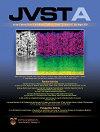Effect of nitrogen pressure on the fabrication of AlCrFeCoNiCu0.5 high entropy nitride thin films via cathodic arc deposition
IF 2.1
3区 材料科学
Q3 MATERIALS SCIENCE, COATINGS & FILMS
引用次数: 0
Abstract
In the past two decades, high entropy alloy (HEA) coatings have attracted great attention due to their superior mechanical properties, outstanding corrosion and oxidation resistance, and exceptionally high thermal stability. In comparison to HEA thin films, high entropy nitrides (HENs) exhibit higher mechanical strength and chemical inertness. In this work, AlCrFeCoNiCu0.5 HEA and HEN thin films were fabricated using a filtered cathodic arc. By regulating the deposition pressure from 0.0005 Pa (HEA thin film) to 0.05 Pa, the nitrogen concentration in each thin film was precisely controlled to tune the mechanical properties. Scanning transmission electron microscopy-energy dispersive spectroscopy revealed that the nitrogen concentration of the films was up to 21.2 at. % at the pressure of 0.05 Pa. The reduced effect of preferential sputtering increased aluminum concentration from 8.3 ± 1.5 to 12.9 ± 2.2 at. % as pressure increased up to 0.05 Pa. X-ray photoelectron spectroscopy further confirmed the formation of AlN and CrN at pressures of 0.01–0.05 Pa. The highest hardness and elastic modulus of the HEN film were 12.4 ± 0.6 and 347.3 ± 17.7 GPa, respectively, which were 84.8% and 131.4% higher than those of the HEA thin film.氮压力对阴极电弧沉积制备AlCrFeCoNiCu0.5高熵氮化物薄膜的影响
在过去的二十年里,高熵合金(HEA)涂层因其优异的机械性能、优异的抗腐蚀和抗氧化性能以及极高的热稳定性而备受关注。与HEA薄膜相比,高熵氮化物具有更高的机械强度和化学惰性。在这项工作中,使用过滤阴极电弧制备了AlCrFeCoNiCu0.5 HEA和HEN薄膜。通过调节沉积压力从0.0005 Pa (HEA薄膜)到0.05 Pa,可以精确控制各薄膜中的氮浓度,从而调节其力学性能。扫描透射电子显微镜-能量色散光谱分析表明,膜的氮浓度高达21.2 at。%在0.05 Pa的压力下。优先溅射的降低效应使铝浓度由8.3±1.5 at提高到12.9±2.2 at。%,压力增加到0.05 Pa。x射线光电子能谱进一步证实了在0.01 ~ 0.05 Pa压力下AlN和CrN的形成。HEN薄膜的最高硬度和弹性模量分别为12.4±0.6和347.3±17.7 GPa,分别比HEA薄膜高84.8%和131.4%。
本文章由计算机程序翻译,如有差异,请以英文原文为准。
求助全文
约1分钟内获得全文
求助全文
来源期刊

Journal of Vacuum Science & Technology A
工程技术-材料科学:膜
CiteScore
5.10
自引率
10.30%
发文量
247
审稿时长
2.1 months
期刊介绍:
Journal of Vacuum Science & Technology A publishes reports of original research, letters, and review articles that focus on fundamental scientific understanding of interfaces, surfaces, plasmas and thin films and on using this understanding to advance the state-of-the-art in various technological applications.
 求助内容:
求助内容: 应助结果提醒方式:
应助结果提醒方式:


